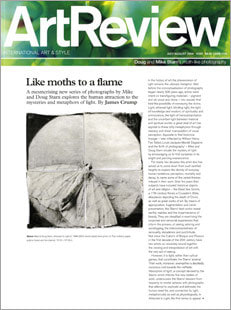
ArtReview
July/August 2004
V2 N7
Like moths to a flame
A mesmerising new series of photographs by Mike and Doug Starn explores the human attraction to the mysteries and metaphors of light.
By James Crump
In the history of art the phenomenon of light remains the ultimate metaphor. Well before the conceptualisation of photography began nearly 300 years ago, artists were intent on transfiguring materials - pigment and oil, wood and stone - into vessels that held the possibility of conveying the divine. Light, ethereal light, blinding light, the light of knowledge and wisdom, of spirituality and omniscience, the light of transubstantiation and the uncertain light between material and spiritual worlds: a great deal of art has aspired to these lofty metaphysics through mastery and sheer manipulation of visual perception. Apposite to that historical lineage - later inflected by William Henry Fox Talbot, Louis-Jacques-Mandé Daguerre and the 'birth of photography' - Mike and Doug Stern situate the mystery of light by encouraging us to find ourselves in its bright and piercing evanescence.
For nearly two decades this artist duo has asked us to come down from such rarefied heights to explore the divinity of everyday human existence, perception, mortality and decay, to name some of the varied themes imbued in their work. Over the years their subjects have included historical objects of art and religion - the Dead Sea Scrolls, a 17th-century Koran, a Crusader's Bible, altarpieces depicting the death of Christ, as well as great works of art By means of appropriation, fragmentation and clever presentation, the Starns' best works reveal earthly realities and the impermanence of beauty. They are steadfast in examining the corporeal and censorial experiences that inform the process of seeing, adoring and worshipping, the interconnectedness of sensuality, decadence and pulchritude. Not since the Cubism of Braque and Picasso in the first decade of the 20th century have two artists so resolutely bound together the viewing and interpretation of art with the very act of seeing.
However, it a light, rather than optical games, that constitutes the Starns' arsenal. Their work, moreover, exemplifies a decidedly conscious nod towards the ineffable. 'Absorption of light', a concept devised by the Starns which informs five new bodies of work, underscores the Starns' descent from heavenly to mortal spheres with photographs that attempt to explicate and delineate the human need for, and connection to, light, metaphorically as well as physiologically. In Attracted to Light, the first series to appear in its entirety, and also the title of a lavish y produced book, they explore the nocturnal and ephemeral nature of moths, the mysteries and magnetic forces that draw these Lepidoptera to light Moths have a distinct literary resonance. From Pliny to Shakespeare, John Donne to James Boswell, Thomas Hardy to Virginia Woolf, writers, much less so than visual artists, have alluded to the butterfly's darker, perhaps more sinister and impure genus mate. 'Has no one.., warned you how despairing the moths are when they are burned?' W B Yeats decries in Two Years Later. Shelley elucidates the otherworldly gloom of Romanticism when he wrote of the 'desire of the moth for the star'. Why is it, one might ask, that so few modern visual artists before the Sterns have attempted to render the moth rather then the gloriously colourful butterfly?
Although the dichotomies of light and dark, good and evil, pure and impure continua to pervade our very notion of the moth, the Starns fix their interest on mimesis and the fragile, dusty media - the wings -that wondrously transport the moth to light The Starns' fascination is grounded in boyhood dreams and fantasies, elaborate fictions that conjure the reveries of moth to flame. These pictures deftly show just how visually arresting the moth is. They twist the hackneyed image of the moth into a monumental object of beauty and wonder, subtly alluding through their use of materials to the brittleness of the moth's existence. 'The complete absorption of light is the black of my eyes,' the Starns write, 'endlessly swallowing and always empty, it's never enough to shine back out.' Eerily staring beck at us, the black voids of the moths' eyes remind us of our own mortality and the brevity of life. In their choice of the nocturnal moth in relationship to the light, and their reckoning of the power in the meaning of black in all its art-historic and scientific usage, the Starns mine their richest and most profound subject to date.
The exhibition, recently shown at Lehmann Maupin in New York, featured large-scale photographs of single moths close up, and much larger grids comprised of up to 150 separate images. Printing on hand-coated Thai mulberry paper, the artists have refined their own technique of toning with sulphur. During processing the silver emulsion softens, with minute portions of it flaking away, before the image is hardened and made permanent. The result renders the printed objects strangely transparent, weightless and dusty - remarkably moth-like, in fact. These shivery pieces of paper, sewn together in grids, call up the tactile if disturbing essence of a swarm of moths. Seeing these colossal images, it's no wonder that ancient Max can cultures timorously considered large moths as the spectre of death.
Nabokov wrote of the 'mysteries of mimicry', which inspired his interest in the moth and butterfly. Mimicry is the base concept of photography, its unique function that delivers reproduction ad infinitum. So it goes that Attracted to Light is the Starns' most shrewd series and probably their most beautiful as well, It is a rare instance today when materiality, metaphor and meaning co like so powerfully in the photographic realm, with such physical and visual grandeur.
Attracted to Light, powerHouse Books, $85 (www.powerhousebooks.com), 'Behind Your Eye ; to 8 Aug, Neuberger Museum of Art, Purchase, NY 10577 (+1 914 251 6100, www.neuberger.org). A two-volume book will be published by the Monacelli Press in 2005 (www.monacellipress.com).
